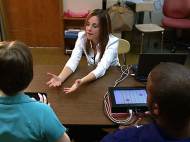Math study for visually impaired made easier with tablet app
 In their effort to study the effectiveness of haptic technology – technology that takes provides feedback to user’s sense of touch by applying forces, vibrations or motions – researchers from the Vanderbilt University designed an application that could assist visually impaired students to master algebra, geometry, graphing and other subjects that are particularly hard to comprehend without the aid of normal vision.
In their effort to study the effectiveness of haptic technology – technology that takes provides feedback to user’s sense of touch by applying forces, vibrations or motions – researchers from the Vanderbilt University designed an application that could assist visually impaired students to master algebra, geometry, graphing and other subjects that are particularly hard to comprehend without the aid of normal vision.
The app is the brainstorm of Jenna Gorlewicz, a graduate student in the Medical and Electromechanical Design Laboratory (MED Lab) at Vanderbilt University, and her adviser Robert Webster, an assistant professor of mechanical engineering, who directs the lab. Although their solution requires a little bit of a learning curve from the students to get to know the new device and signals, it offers greater independence to visually impaired.
“When I began reading articles about haptic technology being incorporated into these new touchscreen devices, I realized that the people who really need haptics are people with impaired vision because they heavily rely on their sense of touch to ‘see’ the world around them”, said Gorlewicz. “I love math and I love teaching, so I immediately thought of using them for math education, because it has such a strong visual component.”
When the project was started, some year and a half ago, the only off-the-shelf tablet that included tactile feedback was a $2,500 model produced for industrial and commercial applications. Luckily, the number of tablets with haptic feedback has increased since then and current consumer tablets with such feature sell for as little as $300.
When the student’s fingertip touches a line, curve or shape displayed on the tablet’s screen, the application returns the feedback by vibration or sound signals. Since the devices can generate vibrations with a number of different frequencies and hundreds of different sounds, there’s a large variety of tactile or audio signals that can be assigned for different features. For example, in an exercise that includes an X-Y grid, she can set the horizontal and vertical lines to vibrate at different frequencies and set points to make a certain tone. In this way, it’s easier for the students to distinguish between the gridlines and the points on the grid.
“When Jenna first approached me with the idea, I thought it would be interesting and might be some small help,” said Ann Smith, a teacher of the visually impaired who works with Kira and Quinn at Hillsboro High School in Nashville. “The more experience I have with it, the more valuable I think it could be. It makes the work more accessible. The students are really interested and they talk about it even when Jenna isn’t here.”
Hillsboro High includes visually impaired students in classes with their sighted peers as much as possible. Smith sits with them during their math classes and uses various methods to ensure that they can follow the teacher’s presentation. She duplicates the shapes and figures the teacher is using on a small white board or a uses tactile aids like pins and pipe-cleaners on a bulletin board with raised graphing lines to reproduce complex mathematical shapes, depending on the degree of impairment.
“Because this takes a certain amount of time, we are always one or two steps behind the teacher”, said Smith. “One of these haptic tablets would allow them to keep up much better. If I didn’t have to attend class with them, it would also make them feel more independent.”
According to Gorlewicz, every time she meets with the students, they come up with new features that they would like her to add. The configuration that they think would be the most useful is a touch-sensitive version of the graphing calculators that are widely used by their sighted classmates.
Since these tablets poses visual, tactile and audio capabilities, they are suitable for students with widely differing degrees of impairment. Another good feature that wouldn’t be too hard to implement is to use the wireless connection to network the tablets with the teacher’s computer and transfer the information from the projected graph or equation on the student’s tablet.









Leave your response!